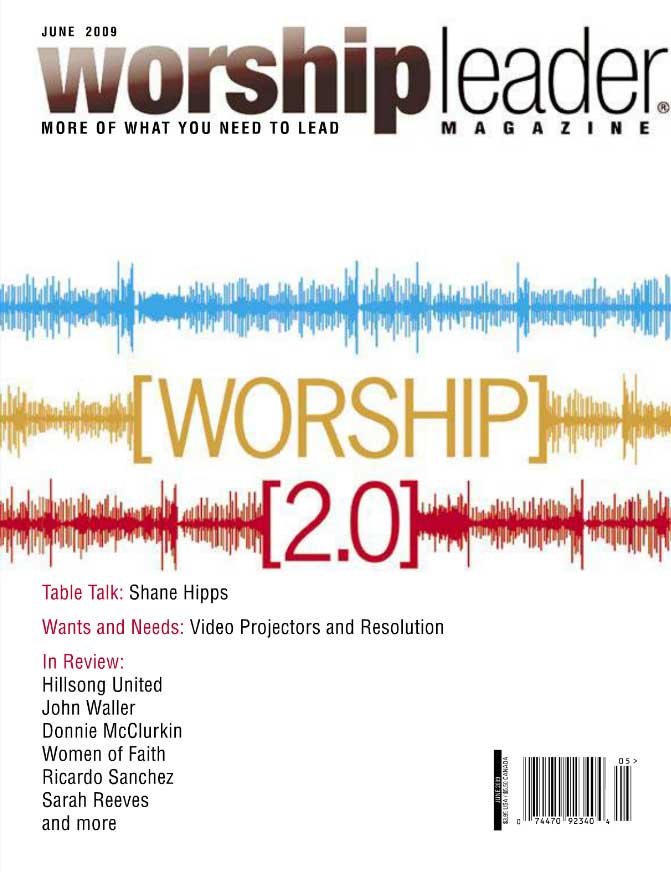The June 2009 issue of Worship Leader Magazine reviewed both our WorshipFlow.com and HymnCharts.com websites.
Download this review as a PDF
Programming Resources
by Warren Anderson
The Internet is increasingly becoming a wellspring of worship resources, with something for churches of every style, structure, and theological bent. Here are two sites that will prove helpful to worship leaders facilitating corporate worship in a wide range of diverse settings.
WORSHIPFLOW.COM
Flow in worship is important. This can’t be reiterated enough. A worship set with abrupt transitions can interfere with the goal of proclaiming God’s narrative through the narrative arc of our corporate worship. Of course, the Holy Spirit can and does work despite such interference, but why make the job more difficult
WorshipFlow.com takes the guesswork out of getting smoothly from one song to the next and alleviates the frustration of forsaking an excellent sequence of songs that heretofore would have been unthinkable (or at least undesirable) because of awkward key changes. The process works like this: Click on the key you’re coming from. Click on the key you’re going to. WorshipFlow spits out a transition that makes sense, no matter how wacky the modulation. You want to move from “I Will Rise” in B to “A New Hallelujah” in G? Click. Click. You’re there – with a lead sheet (chords and keyboard score), chord chart (chords and rhythm), MP3 file, and/or MIDI file to show you the way. Better still, you can choose from 12 different underscore templates to help tailor the transition to the mood you are establishing. In the event that you’re not sure what kind of feel you need, the templates have suggestions for what kinds of songs might work well with each pattern (e.g. “use with songs like ‘Above All'”).
If that wasn’t enough, creator Don Chapman’s site also offers small groups of short hymn interludes, short audio transitions (MP3s), that can be used as soundtracks if you’d rather not or are unable to have the band do the transitions and prayers and readings to accompany popular worship choruses. (Here’s hoping he expands this part of the site in the months to come; these sections could be a real help to creative worship leaders.)
Granted, for some of us, this site will be superfluous, as we have fabulously creative keyboardists who can weave beautiful transitions out of thin air, even if we’re moving from F-sharp to C. For all the rest of us – especially those whose keyboard players function best with printed music – Chapman’s site will prove invaluable. For churches that are wishing to move toward contemporary worship but aren’t quite there yet, WorshipFlow.com could move you along all the more quickly.
HYMNCHARTS.COM
WorshipFlow.com is the kid brother of HymnCharts.com. This was Don Chapman’s first foray into the world of online worship resources, and, to the best of my knowledge, the only worship resource with a standing endorsement from a late-rounds contestant of American Idol (Chris Sligh, with whom Chapman has collaborated on many occasions). HymnCharts.com grew out of Chapman’s church ministry and his desire to bring hymns into the praise band mix. By smoothing out some of the more complex chord structures (utilizing usually no more than two chords per measure) and by adding some gentle pop-rock sensibilities and phrasings, he has succeeded in finding middle ground where well-intended efforts to make hymns palatable to the modern ear occasionally don’t – for rhythmic or harmonic excesses that prove too much for parishioners of a certain age and/or disposition.
Chapman has amassed a collection of 120 classic hymns (at the time of this writing), indexed according to alphabet (both title and hymn-tune name), tempo, key, meter, and season. There is also a hymn-lyrics search engine, which serves as a concordance of sorts. More charts are added at the rate of one or two per month, and Chapman does a good job of processing user feedback and updating and improving the site on a regular basis. Each chart comes with several possible options for use, including two, three, and four-part vocals, keyboard score, parts for C and B-flat instruments, rhythm charts, PowerPoint slides, and several audio options. For example, “The Old Rugged Cross,” has vocal demo, stereo track, drum loop, piano only track, and piano/orchestra track. Many more-recent charts have additional parts as well; for example, “The Old Rugged Cross” has parts for synth strings and sax.
HymnCharts.com is a second excellent resource, one particularly well-suited for churches that are moving toward blending the beset of the old with the best of the new.



